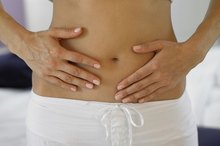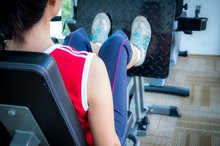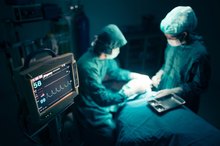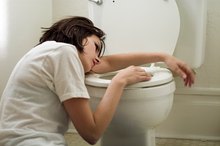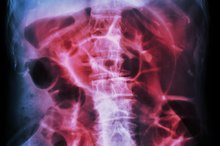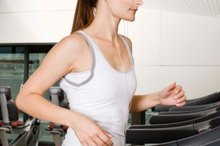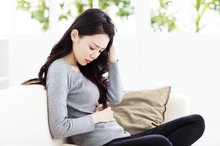Why Your Stomach Hurts After Exercise
You often hear the phrase "no pain, no gain" used in reference to the aches and pains of exercise and muscle development. Unexpected pains may also develop as a result of exercise, including pain in the stomach and abdomen. Stomach and abdominal pain after exercise can be quite intense and may be accompanied by other symptoms as well. This pain can typically be treated, and in most cases can be prevented as well.
Abdominal Pain
Stomach and abdominal pain associated with exercise can present itself in a number of different ways. The pain may occur during exercise or may not begin until after you've finished exercising. Pain may be located in the stomach itself, within the intestines or even in the sides. The intensity and duration of the pain can vary as well, ranging from a dull ache or burning to strong cramps or sharp pains. Symptoms such as nausea, diarrhea, weakness or lightheadedness may accompany the pain as well, though additional symptoms do not occur with every instance of abdominal pain.
Cramps
Bloating & Gas When Exercising
Learn More
Stomach cramps and other muscle cramps can occur either during exercise or soon after. These cramps sometimes result from the affected muscles not receiving enough oxygen during your exercise routine due to excessive anaerobic exercise, though an improper diet or dehydration may contribute to exercise-related muscle cramps as well. Muscles that are not commonly used are more prone to cramping than those which you use frequently, especially if they are used heavily by new exercises that you have incorporated into your workouts. Eating too much or too soon before exercise can increase the likelihood of stomach cramps, as can eating meals high in protein or fat before working out.
Gastrointestinal Distress
Gastrointestinal distress commonly presents itself as nausea, gas pains or diarrhea, with the latter sometimes being referred to as the "runner's trots." These gastrointestinal problems can range from mild to painful and may result in you having to stop your workout to deal with them. Diet and dehydration are major factors in the development of gastrointestinal distress, especially if you eat foods consisting of large amounts of fiber or roughage and drink liquids with a high sugar concentration. Caffeine intake prior to exercise can also irritate the stomach and intestinal tract, leading to gastrointestinal problems.
Exercise-Related Transient Abdominal Pain
Bloating & Gas When Exercising
Learn More
Exercise-related transient abdominal pain, better known as the "stitches" that you get in your side during or immediately after exercise, appear as sudden contractions or cramps that occur in the muscles of the abdominal wall. This pain is thought to be caused by irritation of the parietal peritoneum, the outer layer of the abdominal cavity which connects to the muscles of the abdominal wall. The irritation may be the result of several factors, including internal pressure caused by eating a large meal before exercising and friction caused by jarring movements and exercises that the body isn't used to.
Dehydration Concerns
Dehydration commonly has a role in stomach and abdominal pains that occur as a result of exercise due to the rate at which fluids are absorbed by the stomach and the volume of sweat produced during exercise. During exercise, the body can only absorb around 800 ml per hour; in comparison, heavy exercise can result in the production of close to 2 liters of sweat within that same time frame. Caffeinated beverages and salty snacks can increase the level of dehydration as these act as diuretics that increase the rate at which water is excreted from the body.
Treatment and Prevention
Exercise-related pains of the abdomen and stomach can usually be treated effectively with rest and rehydration. In the case of muscle cramps, massage and ice can help to soothe the cramping muscle and relax the muscle tissue. Abdominal pains and gastrointestinal distress can often be prevented by eating a light meal high in carbohydrates an hour or more before exercise and drinking cool water 20 minutes before exercise begins. Drinking water and low-sugar beverages that contain electrolytes during exercise helps to slow dehydration, while small, carbohydrate-rich snacks eaten during exercise can provide energy without causing gastrointestinal distress or placing excess pressure on the parietal peritoneum.
Related Articles
References
- National Center for Biotechnology Information: Exercise Related Transient Abdominal Pain
- Journal of the College of Physicians and Surgeons -- Pakistan: Dehydration Related Abdominal Pain
- Rice University SportsMed Web: Abdominal Pain in Runners
- MayoClinic.com: Eating and Exercise: 5 Tips to Maximize Your Workouts
- The Summits of Canada: Why Hydrate?
- Marathon Training: Frequently Asked Questions -- Stomach Cramps, Nausea, Diarrhea
Writer Bio
Born in West Virginia, Jack Gerard now lives in Kentucky. A writer and editor with more than 10 years of experience, he has written both articles and poetry for publication in magazines and online. A former nationally ranked sport fencer, Gerard also spent several years as a fencing coach and trainer.
